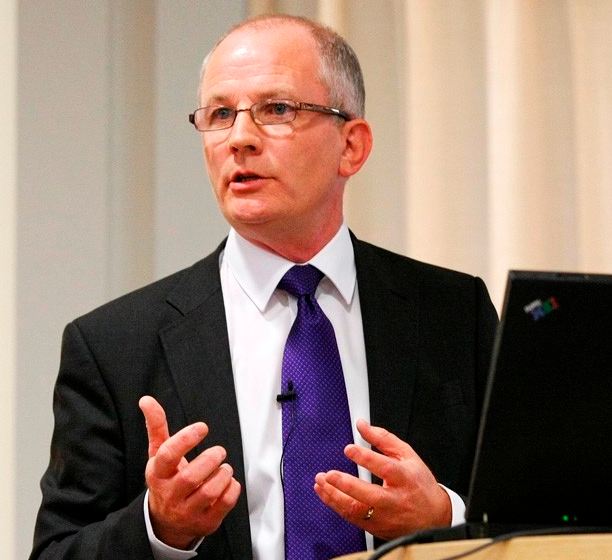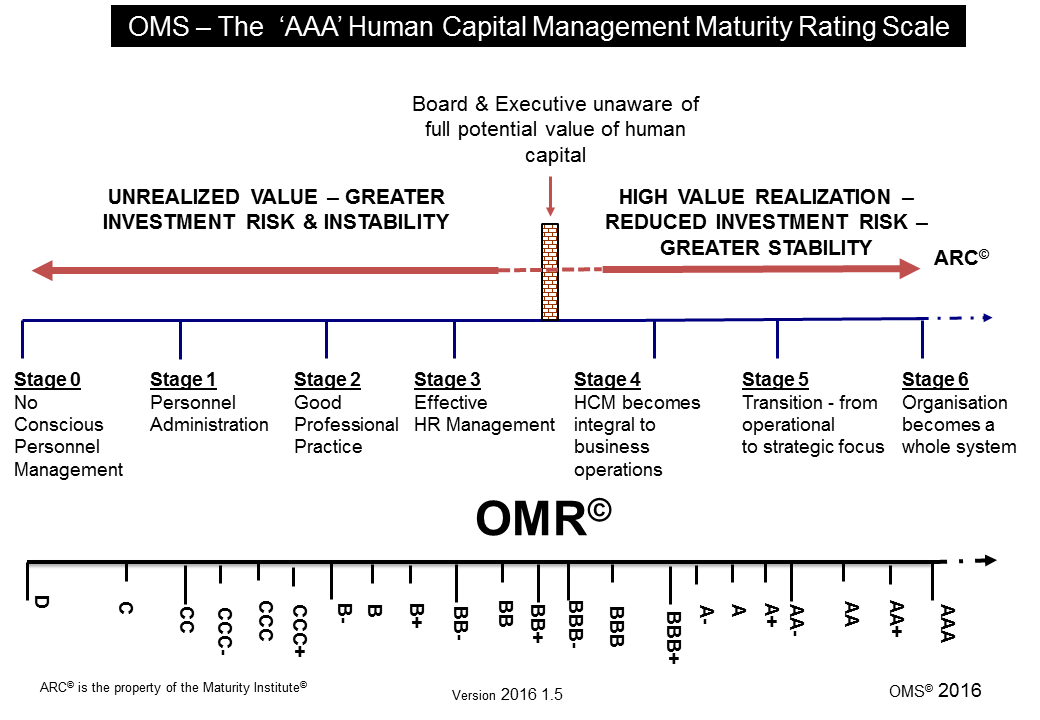U.K. Group Aims to Transform Human Capital Management
How can executives and investors benchmark companies based on their effective use of human capital? OMS LLP, a U.K.-based organization, has developed a human capital rating system known as OMINDEX it hopes will spur organizations around the world to develop more “mature” human capital management practices.
Developed in conjunction with the Maturity Institute, a not-for-profit professional organization, OMS has tested the OMINDEX questionnaire on 70 publicly-held companies, including some in the U.S., and has formed an alliance with a Harvard Law School professor to score the S&P 500 companies in the U.S. based on its methodology. A key goal is to create a commonly accepted platform for managing human capital and helping create a worldwide field of experts to help organizations increase their “organizational maturity.”
 According to Paul Kearns, Senior Partner at OMS LLP and Chair of the Maturity Institute, “OMINDEX grew out the Maturity Institute (MI), a new professional institute whose mission is to maximize societal value through the effective management of human capital. MI was started in 2012 by a small group of dedicated managers and consultants with a shared, special interest in the people dimension of enterprises. The original council comprised two members from the UK, one from Ireland, one from Iceland and one from Australia, and we have now added an American and one based in Canada. Our aim is to be global.”
According to Paul Kearns, Senior Partner at OMS LLP and Chair of the Maturity Institute, “OMINDEX grew out the Maturity Institute (MI), a new professional institute whose mission is to maximize societal value through the effective management of human capital. MI was started in 2012 by a small group of dedicated managers and consultants with a shared, special interest in the people dimension of enterprises. The original council comprised two members from the UK, one from Ireland, one from Iceland and one from Australia, and we have now added an American and one based in Canada. Our aim is to be global.”
According to the Maturity Institute website, “Maturity is aiming to create the maximum value possible from human potential. Human potential refers not only to an organization’s people, but to all people connected with the development, production and supply of an organization’s goods and services. Value is a dual purpose goal relating both to organizational value (e.g. financial, quality, service, efficiency etc.) and societal value (e.g. economic, well-being, environmental).”
The founders believe that the great majority of organizations are failing to maximize the value of human capital, and in a recent study found that a company as successful as Nestle could improve its operating margin by between 5 and 10 percentage points by increasing its organizational maturity, as they define it.
To help translate these goals into practice, the company created the OMINDEX system to make it easier for companies to gauge their level of “organizational maturity.” This is based in part on the Maturity Institute’s fundamental principles for organizational success:
- Value motive: a key value proposition for all organizational constituencies.
- Whole system: effective integration of all of the organization’s parts, as opposed to silos.
- Learning organization: an ongoing dedication to professional and skills development.
- Improvement philosophy: a continuous dedication to fostering and implementing innovation.
- People risk: All of the risks involved with people, including turnover of talent or unethical behaviour.
- Human capital ethos: a clear value system related to the treatment of all people.
- Trust, engagement and cooperation: fostering buy-in and commitment to organizational success.
- Performance system: having a platform for achieving goals, measuring success and identifying flaws.
- Communication: making sure that people are continually informed of all they need to know to succeed.
- Business people sharing: creating a spirit a cooperating and cross-utilization of talent.
The OMINDEX questionnaire has 30 questions to help score each company on the above principles, as well as other strategic planning criteria. Explains Kearns: “Each question is given a percentage weighting so the total scores come to 100%. Then we score each question. The actual type of score can vary from a simple (but systematic) 0 to 10 scale or just a binary yes or no. We build an evidence base for each company to gauge its ‘response’ to each question. The final percentage then translates easily into the AAA scale --- AAA being 100%.” Click here for more information on the questionnaire.
According to Kearns, the Maturity Institute is a not-for-profit organization that encourages members to make a professional living by helping their companies or clients practice MI principles for long-term organizational success. The OMINDEX is designed specifically to convince investors of the benefits of what the Maturity Institute calls Human Governance (HG) and to provide organizations with a means of measuring their maturity scores over time.
Only individuals can join the effort. “We model ourselves on the medical profession – all of our members have to work to our very high standards. They come from a variety of backgrounds, which is our aim. Maturity is a composite philosophy on organizational management and therefore needs a multi-disciplinary team who know how to work with each other towards our goal of maximum societal value.” MI currently has 31 “oriented” members, meaning they have received training. The goal is to build a force of experts representing multiple business disciplines who can help companies run according to maturity principles.
Kearns says his organization is “just about to launch a complete rating of the S&P 500 for a research project with Harvard Law School’s Pensions and Capital Stewardship Project, working with Professors Larry Beeferman and Aaron Bernstein. We also have interest from other partners in France to cover the SBF 120, in Australia to cover the ASX 100, and from associates in Sweden to cover the Nordic OMX 40. Long term, we aim to have a complete, global OMINDEX using the same universal standards all related back to MI’s Maturity Scale.”
The challenge is getting companies to cooperate. For the first study of 70 companies, not one company volunteered. “We view and observe organizations from a very different perspective: through the lens of the people who work there – how engaged are they, how strong is the psychological bond, how are they developed, encouraged to produce ideas etc.? Even if we were invited in with our questionnaire, companies would need a lot of help to answer our questions because they haven’t been trained in this mature perspective.” That said, Kearns adds that “we can already glean many answers to our questions. For example, when a company says it does thousands of hours training, if it doesn’t say why or how, what method it’s using, or whether it has a learning system in place, that reveals an enormous amount about its level of maturity.” For its initial study, MI gleaned its answers from publicly available documents, including annual reports, securities filings and other sources.
Kearns explains that for the U.S. effort with Harvard Law School, “We will make an approach to the S&P 500 to invite them to engage with us in the research. We expect to have the same response as before: large organizations, particularly, are defensive and resistant to exposing their inner workings. When they realize we will only bring good, we believe the early adopters will emerge and work with us. I don’t mind admitting that Harvard’s reputation goes before it and will make this task a lot easier.”
We asked Kearns if he believes that CEOs and CFOs are convinced there’s enough data to suggest that human capital utilization is a differentiator in terms of creating corporate value.
 “Absolutely and unequivocally yes,” he says, “but only when they are presented with a clear, causal connection between practice and value impact. At an investment association conference in London last year, with over 100 investment and senior management participants, my colleague Stuart Woollard presented our research note on Nestlé with our claim that it could improve its operating margin by between 5 and 10 percentage points, and a senior investment manager on the panel agreed immediately.”
“Absolutely and unequivocally yes,” he says, “but only when they are presented with a clear, causal connection between practice and value impact. At an investment association conference in London last year, with over 100 investment and senior management participants, my colleague Stuart Woollard presented our research note on Nestlé with our claim that it could improve its operating margin by between 5 and 10 percentage points, and a senior investment manager on the panel agreed immediately.”
That said, Kearns adds: “Do all CEOs and CFOs get it yet? No, of course not. Where would they have learned this? It is not currently taught in any business school and the accounting profession still regards human capital as an intangible. MI was set up to educate them otherwise and we have plans to establish a brand new business school to do exactly this, including our financial experts who help us to show clear connections between people and significant enterprise value opportunities.”
Kearns doesn’t believe that publicly- held companies need to be compelled to share this information. “If CEOs and Chief Financial Officers can be convinced of the tangible value of human capital management, then why would we need to impose regulations on them to do something that is so obviously in their own interests (and in those of their employees and shareholders)? OMINDEX aims to provide global evidence that this simple hypothesis is valid and, don’t forget, MI’s original exemplar (and benchmark for OMINDEX) is Toyota, a company that every other manufacturer has tried to emulate and one that has four times the market capitalization of GM. If GM management hasn’t learned the secrets of Toyota’s fantastic people management capability after nearly 80 years, then I don’t think regulation is going to help them. Their immature mindset will miss the point and just see the regulations as another box to tick.”
Kearns says that while the concept of maturity may have started in automotive manufacturing, it can be applied to any organization, publicly held or not, profit or not-for-profit. “One of the best examples we have found actually comes from the not-for-profit sector. It is Buurtzorg in the Netherlands, an amazing and very inspiring story in healthcare that now has a U.S. operation as well.” Buurtzorg has an innovative approach using self-governing nurse teams that reportedly has drawn widespread attention in the healthcare field.
“The big breakthrough,” Kearns feels, “will soon come from the mainstream investment community, because we have the evidence that higher maturity levels brings huge value to enterprises. The canny investors will want to get in just before an enterprise makes that key decision to embark on its own maturity journey.”
What is the organization’s ultimate objective? Kearns explains: “Create maximum societal value from the world’s sustainable resources with human capital, at all levels, rewarded appropriately for their own contribution.”
The company is currently seeking sponsors for its S&P 500 analysis project with Harvard.
For more information, contact:
Paul Kearns
Senior Partner, OMS LLP
Chair, Maturity Institute
Tel. 44 (0) 7974794647















